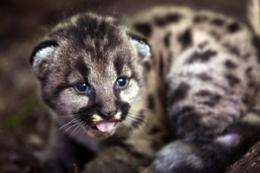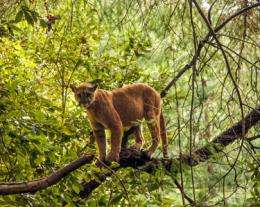Apple's software brings attention to mountain lion research

Apple's release this week of its Mac OSX "Mountain Lion" operating system is drawing attention to the real thing prowling the wooded hills just a few miles from the company's Cupertino headquarters.
Since 2008, UC Santa Cruz researchers have captured 36 mountain lions (Puma concolor) in the Santa Cruz mountains as part of the UCSC Puma Project to better understand the big cats' physiology, behavior, and ecology.
High-tech collars
They've outfitted the lithe, tawny-colored predators with high-tech electronic collars that show where the mountain lions are and where they have been. Fourteen still have active GPS collars, said UCSC environmental studies Ph.D. student Yiwei Wang. Two others are followed manually. Of the remaining 20 lions, some collars have failed, or the lions have disappeared or died.
Earlier this summer, a young male known as 35M was watched electronically as he ventured from Scotts Valley where he was first captured, collared, and then released, to Morgan Hill, then up the Peninsula nearly to San Francisco. Now, Wang reports, 35M seems to have settled down west of Portola Valley.
Wang explained that a young male mountain lion must venture out alone from his mother's care and build his own territory while avoiding other males, including his own father, who may try to kill him. 35M may stay put or may pick up and keep moving, Wang reports in her blog post at SantaCruzPumas.org, the web site that documents the mountain lion research project. It includes maps showing 35M's travels over the past few months.

Motion-activated cameras
Researchers also place motion-activated cameras in the field. The web site includes photos of kittens born to a female, 23F. Wang and her colleagues used GPS data to track 23F to Nisene Marks State Park near Aptos where they found her three kittens born in early May. They captured video of the squeaking kittens nursing earlier this month.
Another video on the site shows a lion coughing up a hairball just as a domestic cat might.
The mountain lion research project is a partnership between UC Santa Cruz and the California Department of Fish and Game. Led by Chris Wilmers, a UCSC assistant professor of environmental studies, the team includes graduate students such as Wang, other wildlife biologists, UCSC professor Terrie Williams, an animal physiologist, UCSC engineering associate professor Gabriel Elkhaim, and houndsmen – both volunteers and from the Department of Fish and Game – who, with their dogs, are essential for the on-the-ground tracking and capturing of the big cats.
The research team has developed a state-of-the-art wildlife-tracking collar that simultaneously tracks the location and behavior of the animal wearing it. The collar includes an accelerometer that measures movements in three directions and an electronic compass. Wang said researchers use Apple products, such as MacBook laptops for data analyses, iPhones to receive GPS information directly from the collars, and iPads for educational field trips.
Wilmers, a wildlife ecologist, is also investigating the fragmentation of the mountain lions' habitat from urban encroachment. In particular, freeways such as highways 17 and 101and Interstate 280 slice through mountain lion pathways. Wilmers is studying whether culverts and overpasses at known crossing areas might allow the animals to safely pass into other territories.
31 highway crossings
One mountain lion, 16M, is both a traveler and a survivor. Since May 2010, Wilmers and his team have documented 31 times that 16M has successfully crossed Highway 17 between San Jose and Scotts Valley. It's been tough, though, he was hit and badly injured in November 2010, and his pregnant mate, 18F was killed last year crossing the winding highway.
More than half of California is mountain lion habitat. As humans expand their footprint into this habitat, conflicts between mountain lions and domestic animals are increasing. Mountain lions prefer deer but may eat pets and livestock if left unprotected outside.
In the last decade, an average of about 100 lions were legally killed each year for predating on domestic animals, Wang said. Attacks on humans are extremely rare, and most encounters between the two species last a few seconds.
More information: santacruzpumas.org/
Provided by University of California - Santa Cruz
















